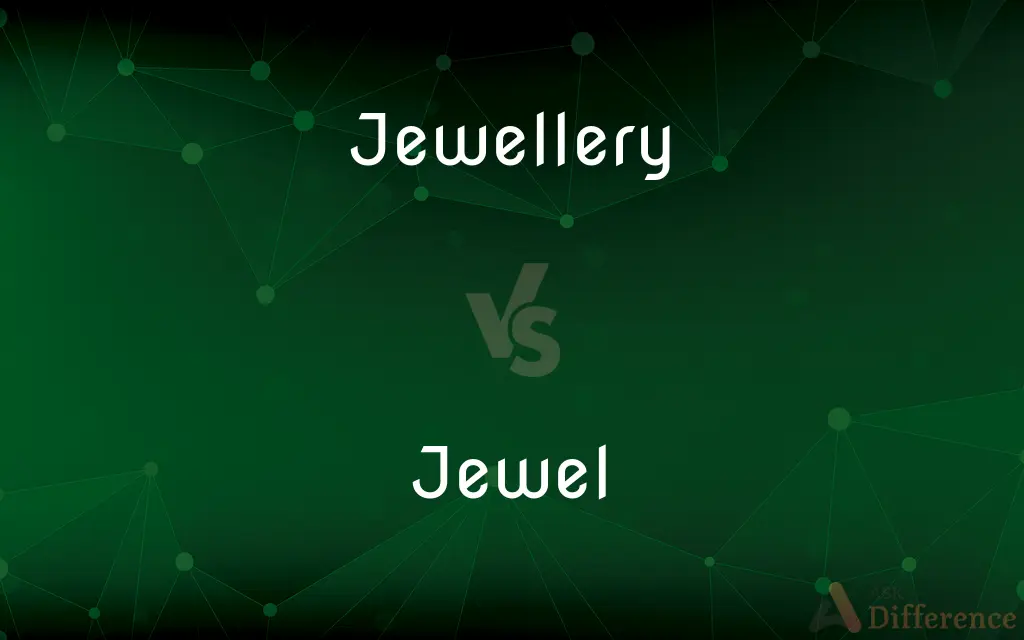Jewellery vs. Jewel — What's the Difference?
By Urooj Arif & Maham Liaqat — Updated on March 4, 2024
Jewellery refers to decorative items worn for personal adornment, such as rings or necklaces, while a jewel is a precious stone used in crafting these items.

Difference Between Jewellery and Jewel
Table of Contents
ADVERTISEMENT
Key Differences
Jewellery encompasses a wide range of decorative items designed for personal adornment, such as rings, necklaces, earrings, and bracelets, often made from or containing jewels and precious metals. On the other hand, a jewel specifically refers to a precious or semi-precious stone that is cut, polished, and used in the creation of jewellery. Jewels, such as diamonds, rubies, and sapphires, are valued for their rarity, beauty, and durability.
While jewellery serves as an accessory to enhance personal style and often symbolizes wealth, status, or commitment, a jewel's value is primarily determined by its rarity, color, clarity, cut, and carat weight. Jewellery can be made with a variety of materials, including metals, beads, and even textiles, but it becomes especially prized and valuable when it incorporates jewels into its design.
The crafting of jewellery is an art form that combines metalsmithing techniques with gemology, the science of gems, to create pieces that are both beautiful and durable. Whereas, the selection and preparation of jewels for use in jewellery involves specialized knowledge and skills, including cutting, polishing, and setting the stones to best display their natural beauty.
Jewellery can range from simple and understated to elaborate and ornate, reflecting cultural traditions, fashion trends, and personal taste. In contrast, jewels are admired for their inherent beauty and are often the focal point of the jewellery pieces in which they are set, contributing significantly to the item's overall appeal and value.
The significance of jewellery and jewels extends beyond their aesthetic appeal, as both can carry deep personal, cultural, and historical meanings. Jewellery pieces are often cherished as heirlooms, symbols of love, or markers of significant life events. Meanwhile, specific jewels might be sought after for their supposed protective qualities or symbolic meanings, adding an additional layer of value and significance.
ADVERTISEMENT
Comparison Chart
Definition
Decorative items worn for personal adornment
Precious or semi-precious stone
Components
Made from various materials including jewels
Constitutes the precious element in jewellery
Purpose
Enhances personal style, symbolizes wealth or commitment
Valued for rarity, beauty, durability
Crafting
Combines metalsmithing with gemology
Involves cutting, polishing, and setting
Value Determinants
Design complexity, materials used, craftsmanship
Rarity, color, clarity, cut, carat weight
Cultural Significance
Can carry symbolic meanings, used in traditions
Often attributed with protective or symbolic qualities
Compare with Definitions
Jewellery
Jewellery can be made from metals, jewels, or other materials.
The artist creates jewellery from recycled materials.
Jewel
Cutting and polishing are key in jewel preparation.
Expert craftsmen cut the jewel to enhance its brilliance.
Jewellery
Jewellery varies in style and complexity.
The exhibition displayed ancient jewellery from various cultures.
Jewel
A jewel is a precious stone like a diamond or ruby.
The crown was adorned with jewels of every color.
Jewellery
Jewellery refers to decorative items like bracelets and earrings.
She wore elegant jewellery to the gala.
Jewel
It is used in crafting jewellery.
The jeweler sourced rare jewels for his masterpiece.
Jewellery
It is used for personal adornment.
His gift to her was a piece of fine jewellery.
Jewel
Jewels can have symbolic meanings.
In many cultures, jewels are believed to offer protection.
Jewellery
It often symbolizes status or commitment.
Engagement rings are a form of jewellery symbolizing commitment.
Jewel
Jewels are valued for their beauty and rarity.
The museum's exhibit featured jewels from around the world.
Jewellery
Jewellery or jewelry consists of decorative items worn for personal adornment, such as brooches, rings, necklaces, earrings, pendants, bracelets, and cufflinks. Jewellery may be attached to the body or the clothes.
Jewel
A precious stone; a gem.
Jewellery
Personal ornaments, such as necklaces, rings, or bracelets, that are typically made from or contain jewels and precious metal
She had silver hair and chunky gold jewellery
A jewellery box
Jewel
A small natural or artificial gem used as a bearing in a watch.
Jewellery
Collectively, personal ornamentation such as rings, necklaces, brooches and bracelets, made of precious metals and sometimes set with gemstones.
She had more jewellery ornamented about her than any three ladies needed.
Jewel
A costly ornament of precious metal or gems.
Jewellery
See Jewelry.
Jewel
One that is treasured or esteemed.
Jewellery
An adornment (as a bracelet or ring or necklace) made of precious metals and set with gems (or imitation gems)
Jewel
To adorn with jewels.
Jewel
A precious or semi-precious stone; gem, gemstone.
Jewel
A precious stone; a gem.
Jewel
A precious or semiprecious stone incorporated into a piece of jewelry
Common Curiosities
What makes a jewel valuable?
A jewel's value is determined by factors like rarity, color, clarity, cut, and carat weight.
Can jewellery exist without jewels?
Yes, jewellery can be made from a wide range of materials without the inclusion of jewels.
How are jewels incorporated into jewellery?
Jewels are cut, polished, and set into jewellery pieces to enhance their beauty and value.
What distinguishes jewellery from a jewel?
Jewellery refers to decorative items worn for adornment, incorporating various materials, including jewels, whereas a jewel specifically denotes a precious stone.
Can the term 'jewellery' refer to a single item?
Yes, 'jewellery' can refer to both individual items and collections of decorative pieces.
How is the quality of a jewel assessed?
The quality of a jewel is assessed through gemological standards, including its cut, color, clarity, and carat weight.
Can jewellery be an investment?
Yes, jewellery, especially pieces containing high-quality jewels, can be a significant investment.
Are all jewels natural?
While many jewels are natural, there are also synthetic or lab-created jewels.
What is the significance of jewellery in fashion?
Jewellery plays a crucial role in fashion as an accessory that complements personal style and outfits.
What is gemology?
Gemology is the science of gems, focusing on their identification, grading, and evaluation.
How are jewels sourced?
Jewels are sourced from mining or synthetic production, followed by a rigorous selection process.
Do all cultures value jewellery and jewels the same way?
Cultural values and meanings attributed to jewellery and jewels vary widely around the world.
Can jewellery have historical significance?
Yes, many jewellery pieces have historical significance, reflecting the art, culture, and technology of their times.
What are some common jewels used in jewellery?
Common jewels include diamonds, rubies, sapphires, and emeralds.
What is the role of craftsmanship in jewellery?
Craftsmanship determines the quality, durability, and beauty of jewellery, especially in how jewels are set and metals are worked.
Share Your Discovery

Previous Comparison
Debutante vs. Cotillion
Next Comparison
Wheat vs. CornAuthor Spotlight
Written by
Urooj ArifUrooj is a skilled content writer at Ask Difference, known for her exceptional ability to simplify complex topics into engaging and informative content. With a passion for research and a flair for clear, concise writing, she consistently delivers articles that resonate with our diverse audience.
Co-written by
Maham Liaqat













































